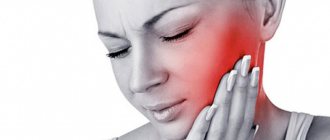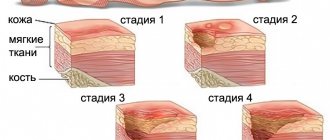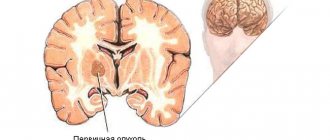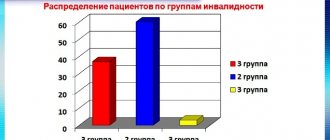Kurganskaya Natalia Valerievna Doctor - obstetrician-gynecologist
✓ Article verified by a medical expert
Hot flashes are a strong sensation of heat that spreads throughout the body and is usually strongest in the head (face) and neck area. This condition can occur at any time of the day and is accompanied by a sharp rise in temperature, increased heart rate, redness of the skin and profuse sweating. Sometimes the listed symptoms are supplemented by flickering in the eyes, ringing in the ears, difficulty breathing and mental anxiety. The duration of hot flashes ranges from 30 seconds to several minutes.
The appearance of hot flashes can be observed both in women (a characteristic symptom of premenopause) and in men (as a result of a critical decrease in testosterone levels).
Etiology of the symptom
Sensitive skin reacts to sudden changes in ambient temperature, which is manifested by a feeling of heat.
A common reason why the face, in particular the forehead, can burn is a change in ambient air temperature. The provoking factor in this case is a sensitive skin type, which reacts in this way, for example, when leaving a hot bath into a cooler room.
When you get a sunburn or, conversely, frostbite, the skin loses moisture. This provokes thinning of the epidermis and an increase in its sensitivity to harmful external factors.
If there is no fever, but the forehead and cheeks are hot, this may be a consequence of drinking alcohol. In addition to facial redness, blood pressure may rise and swelling may occur.
If spicy spices were added during the preparation of the dish, your forehead or cheeks may turn red after the feast. This is the body’s reaction to the seasoning, which can be complemented by increased heart rate and disruption of the gastrointestinal tract.
A natural phenomenon is facial redness after high physical exertion. It is not recommended to abuse them. If the load is significantly exceeded, a heart attack is possible.
Diseases that occur with redness of the face
Various dermatological diseases occur with redness of the skin of the face, in particular the forehead, cheeks, and nose. This could be acne or rosacea, demodicosis, psoriasis, etc. Hot to the touch and reddened areas are caused by vasodilation. The disease progresses with the formation of a specific rash, which has a distinctive appearance in each specific case.
If a person suffers from hypersensitivity of the skin to a certain provoking factor, for example, to a specific type of cosmetics or material for making hats, in addition to an increase in local temperature and redness of the face, the action of the provocateur causes itching, burning, and swelling, which can reach an impressive size.
Acute respiratory infections and colds may not be accompanied by an increase in general temperature, but occur with heat in the face and redness. Symptoms include general malaise, runny nose, cough, and drowsiness.
As the disease progresses, fever, chills, sneezing, and increased lacrimation occur. To prevent complications, you need to stay in bed and follow the recommendations indicated by your doctor.
Redness of the forehead and face in general is often observed in people suffering from osteochondrosis of the cervical spine. In addition, I have a throbbing headache. Symptoms are caused by insufficient oxygen supply to the brain due to impaired circulation in the cervical structures.
Vegetative-vascular dystonia is another pathology that is not officially recognized as a disease, but causes quite pronounced symptoms that interfere with the quality of life. In addition to facial redness and hot flashes, a person is worried about a rapid heartbeat, a feeling of shortness of breath, a panic attack, and increased sweating. The body may become covered with red spots, which is caused by vascular spasm.
Diseases of the thyroid gland and changes at the hormonal level (during pregnancy, menopause, adolescence) often occur with hot flashes and a feeling of heat on the face.
A hot forehead is a symptom of diseases of the cardiovascular system. This could be hypertension, which occurs with headaches, a feeling of lack of air, and swelling.
Most psychological disorders occur with a rush of blood to the head and redness of the face. Neuroses and psycho-emotional fatigue are accompanied by similar symptoms.
Causes of hot flashes
Flushing and a feeling of heat may be due to the following reasons:
- dysfunction of the cardiovascular system, hypertension;
- increased blood pressure in healthy people in stressful situations;
- a decrease in estrogen levels and a combination of biochemical and hormonal fluctuations in women during menopause;
- atherosclerosis (hot flashes are accompanied by noise in the head and pain in the temples);
- malignant formations of various etiologies;
- excess body weight;
- exhausting physical activity;
- drinking alcohol and smoking;
- taking certain medications;
- serious infectious diseases;
- hereditary predisposition;
- elderly age.
Hot flashes can also be triggered by eating foods that contain capsaicin (such as hot chili peppers) or high temperatures.
Symptoms and manifestations
A hot head is not a separate disease, but a symptom that accompanies certain pathologies. Feelings in this condition:
- sudden rush of blood to the forehead or other part of the face;
- redness of the forehead;
- increased sweating.
Associated symptoms:
- fear and anxiety;
- headache and dizziness;
- lack of air;
- increased heart rate;
- increased sweating;
- nausea;
- hand tremors
Depending on the cause of the facial heat, the duration of the symptom may vary for each patient. The condition may improve within a minute or persist for one day or more.
The child has a high temperature. What to do?
High temperature is a protective reaction of the body that enhances the immune response.
In our body, the hypothalamus is responsible for the mechanism of temperature regulation.
This tiny area in the head is made up of a huge number of nerve cells. They regulate the activity of the human cardiovascular, endocrine, digestive and excretory systems.
The hypothalamus is responsible for sleep patterns, wakefulness, hunger, thirst, the reproductive system, pleasure, expression of emotions, social interaction and regulates body heat exchange.
Normally, the hypothalamus maintains the temperature of a healthy person within 36-37°C. Through receptors on the skin, it reacts to cold or heat, as well as to any changes in blood temperature.
As soon as the body is attacked by viruses or bacteria, our cells release pyrogens - substances that increase the temperature.
A person begins to shiver - this is how the muscles contract in the hope of warming up, and the blood vessels in the skin narrow to reduce heat loss.
That is why an increase in temperature in both adults and children is accompanied by:
- lethargy - active movement leads to heat loss
- trembling - muscles contract to keep the body warm
- pallor - due to spasm of peripheral vessels
- desire to wrap yourself up warmer
Why is the temperature rising?
The anterior portion of the hypothalamus contains heat-sensitive nerve cells that respond to any changes in blood temperature and impulses from heat/cold receptors on the skin.
Under the influence of bacteria and viruses, our cells release pyrogens - substances that increase temperature. When the thermoregulation center “decides” that there is a need to maintain a higher body temperature than usual, the body begins to “think” how to achieve this.
You can do this in two ways:
1. Increased heat generation (try to warm up).
2. Reduced heat transfer (prevent heat from escaping from the body).
Then the following happens. Due to impulses running along the muscle fibers, a person begins to shiver - this is how the muscles contract in the hope of warming up. At the same time, the vasomotor center receives information that it is necessary to stop heat loss. To do this, the blood vessels in the skin “block” (spasm), and heat transfer decreases. Bottom line: the hypothalamus is “happy” that the body temperature remains around 39.0°C.
This results in a standard febrile child. He:
- sluggish - the hypothalamus does not allow active movement, because this will lead to heat loss
- trembles - muscle contractions increase heat generation
- pale - pale skin occurs due to spasm of peripheral vessels
- tries to wrap himself up warmer
But the body is very delicately structured - it will not allow you to overheat to a critical point. Therefore, when the temperature set by the hypothalamus is exceeded, the vessels in the periphery dilate, the sweat glands are activated and heat transfer increases.
Now the child turns red, sweats profusely and tries to quickly throw off the blanket.
The high body temperature will be maintained until the cause of its increase (infection, tumor, etc.) is eliminated. After the cause disappears, the hypothalamus sets the parameters for a new normal temperature.
How to act in case of fever?
First of all, don’t worry and don’t rush to bring down the temperature. It is important to remember that this is a natural protective reaction of the body. The child’s immune system begins active synthesis of protective substances only at temperatures above 38.5°C.
First of all, you need to assess the child’s overall well-being, his behavior and appearance. This will help you make an informed decision for further action.
Fever is always accompanied by other symptoms.
Regardless of the temperature and age of the baby, there are symptoms that require immediate examination by a pediatrician:
- atypical behavior - high-pitched crying, drowsiness, moaning
- Strong headache
- convulsions
- disturbance of consciousness
- lowering blood pressure
- persistent vomiting or diarrhea
- abdominal pain
- sore throat or ear
- inability to bend the head to the chest (this causes sharp crying)
When such conditions occur, antipyretic therapy alone is not enough. It can even cause harm. A timely examination by a pediatrician and a thorough diagnosis are necessary.
It is important to consider the age of the child with a fever.
It's better not to put off visiting a doctor:
- for a baby less than 3 months old at a temperature of 38.0°C or more
- from 3 months to 3 years - over 38.0°C for 3 days or over 39.0°C
- at a temperature above 38.6°C for 3 days in children over 3 years of age
- temperature above 39.4°C
- in the presence of chronic diseases
- lack of improvement in health when the temperature drops
- reappearance of fever after normalization of temperature
- lack of tears when crying, rare urination, dry skin and mucous membranes
- refusal to eat and drink
Regardless of the age of the child, it is necessary to bring in an examination if the following symptoms occur:
If mom or dad thinks that something is wrong with the child, it is better to play it safe and get examined as soon as possible.
When is it necessary to lower the temperature?
1. The child, regardless of the height of the temperature, does not feel well (the main task is to alleviate his condition).
2. A child with chronic somatic diseases (pathologies of the heart, lungs, brain or nervous system).
If a child older than 3 months has a rectal temperature below 38.9°C and feels well, it is not advisable to lower the temperature. It is important to understand that an increase in body temperature is a natural protective reaction of the human body. The immune system begins active synthesis of various protective substances only at a temperature of about 39°C.
In any case, if you are not sure about the need for antipyretic therapy, you should consult a pediatrician.
How to lower the temperature?
It is important to understand that taking antipyretics is aimed at relieving the child’s discomfort. It does not shorten the duration of the disease or reduce the risk of complications.
At home, children can lower their temperature with only two drugs - paracetamol (from 3 months) and ibuprofen (from 6 months).
All antipyretic drugs should be dosed not according to age, but according to the baby’s weight.
A single dosage of paracetamol is calculated at 10-15 mg/kg of weight, ibuprofen 5-10 mg/kg of weight.
If the antipyretic is in the form of a suspension of ibuprofen (in 5 ml - 100 mg), paracetamol (in 5 ml - 120 mg), then you need to divide the amount calculated by weight in mg by the amount of the drug in 1 ml.
Ibuprofen can be taken 3-4 times a day, paracetamol - 4-5 times.
Let us note one important nuance. Do not lower the temperature with Ibuprofen in a child with chickenpox (chickenpox). This drug may make the disease more severe.
How to give an antipyretic?
There are several rules for taking antipyretic drugs:
1. Give an antipyretic no more than 5 times a day.
2. Do not lower the temperature of a child under 3 months without being examined by a doctor.
3. Do not give combined antipyretic drugs, for example ibuprofen + paracetamol.
4. Carefully read labels and instructions for medications.
5. Shake the bottle before giving the drug to the child.
6. Before taking the drug, make sure the correct dosage. A small dosage will result in reduced effectiveness, and an overdose can cause various side effects.
7. Do not use a teaspoon for calculations (different spoons have different capacities). To measure, it is better to give preference to a measuring spoon or dosage syringe.
8. Record in a notebook when and how much of the drug was given to the child.
9. Observe the child’s body - for some, Ibuprofen is more suitable, and for others, Paracetamol.
10. When lowering the temperature, do not try to reach 36.6°C. If, after taking an antipyretic, the temperature drops by 1-1.5°C, and the child becomes active and cheerful, the goal has been achieved.
11. If after taking an antipyretic the temperature does not decrease, a pediatrician’s consultation is required.
Diagnosis and treatment
To exclude or confirm an allergic reaction, special tests are done.
To exclude the allergic nature of the heat on the face, skin tests and other studies are performed. To exclude a disease of dermatological etiology, a sample of biological material taken from the patient is taken by scraping. A blood test is required to exclude the infectious nature of the symptom.
Treatment is prescribed depending on the cause of the heat on the face.
- Normalization of the emotional background. If a person has suffered stress, you need to take a sedative that will help get rid of anxiety and anxiety.
- The right way of life. It is necessary to eliminate bad habits (smoking, drinking alcohol, taking drugs) that negatively affect the condition and functioning of blood vessels.
- Maintaining a balanced diet. Spices, hot seasonings, spices, fatty, fried, smoked foods should be excluded.
- Using cosmetics that suit your skin type. It is better to select cosmetic products marked “hypoallergenic” or with a composition that is closest to natural.
If you have a hot face and redness caused by hypothermia, overheating, or exposure to other external factors, you can try to cope on your own using folk remedies:
- oatmeal: 2 tbsp. pour 50 ml of boiling water over the flakes, leave to steam for 20 minutes, apply the paste to the forehead, leave for half an hour;
- cottage cheese and kefir: mix the ingredients in equal quantities, apply the mask to the face, leave for 20-30 minutes;
- cucumber: peel the vegetable, grate the pulp, apply to the face, leave for 10-20 minutes.
If you suspect a specific disease, which may occur with fever on the face, it is recommended to visit a doctor and undergo a comprehensive diagnosis.
Prevention
In hot weather, it is necessary to wear a hat.
Specific preventive measures regarding redness and heat on the face have not been developed. It all depends on what specific disease they should be aimed at.
General preventive measures:
- wearing a hat in sunny weather;
- using sunscreen before going outside;
- use of cosmetics suitable for your skin type;
- avoiding exposure to frost or cold winds;
- maintaining proper nutrition and lifestyle in general.
A hot head, if such a phenomenon is observed in isolated cases, is not a reason to see a doctor. If the symptom is present frequently or on an ongoing basis, it is better to undergo a comprehensive examination.
Diagnosis of hot flashes
If you regularly experience even short-term flushes of blood, you should definitely consult a doctor, especially if the flushes are accompanied by dizziness, a sharp rise in temperature or severe chills. Diagnostic methods are designed to determine the main cause of the disease state and exclude (or identify) such serious and dangerous pathologies as malignant tumors. You will need to consult a gynecologist and endocrinologist. The doctor prescribes a pelvic ultrasound and other necessary examinations, and, after determining the cause and nature of the hot flashes, determines the course of treatment.










